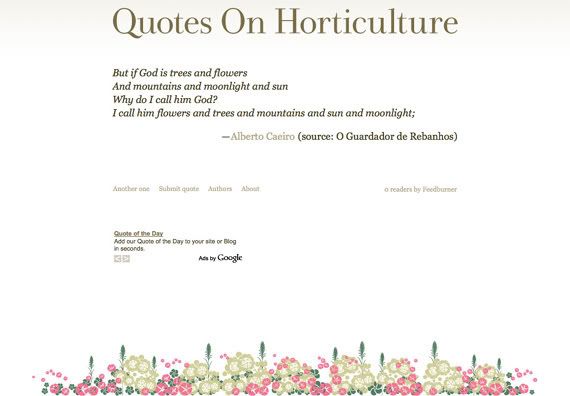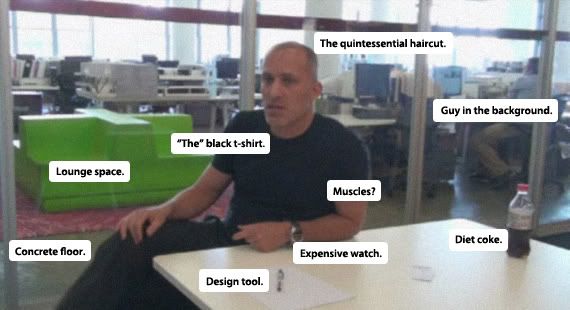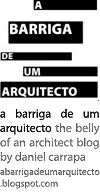Quotes on Horticulture
Published Saturday, February 28, 2009.
Quotes On Horticulture is a lovely website by José Rui Fernandes - the author of Jardinagem.org (a gardening journal in Portuguese only).
Okay, so this is the only thing I’ll say about the Oscars: Peter Gabriel’s Down To Earth should have won the award for Best Song. And here’s an amazing home video by Anthony Meadows with some seriously groovy WALL-E action. This is just one of the sweetest things I’ve seen in a long time. And if you like it, make sure you click here for more.

Beautiful website by photographer Carlos Hernandez featuring amazing portraits, landscape and architecture. The “Urban Climbing” series is particularly engaging. He also has some great stuff on his personal blog.
An insightful interview with Simon Johnson on Bill Moyers Journal, talking about the ethical dimension of the financial crisis that is sweeping the american banking system.
My big thanks to BUILD Blog
Published Friday, February 20, 2009.
My big thanks to the nice folks at BUILD Blog for featuring me on their page with such sweet words of incentive.
I would like to say to all the visiting BUILD Blog readers that this is the english-only version of my original blog, [a barriga de um arquitecto], published in bilingual Portuguese-English and started in December 2003.
Thanks for visiting!
I would like to say to all the visiting BUILD Blog readers that this is the english-only version of my original blog, [a barriga de um arquitecto], published in bilingual Portuguese-English and started in December 2003.
Thanks for visiting!
The Crisis of Credit Visualized and other links
Published Thursday, February 19, 2009.The Crisis of Credit Visualized presents an amazing animated video that explains the financial credit disaster in clear-cut terms.
Frontline: Inside the Meltdown chronicles the events that led to the current economic crisis. The full program can be watched online.
Dubai Real Estate Crash shows how the crisis is affecting the local market.
Barry Schwartz talks about The Real Crisis on TED.
Via Coudal, TreeHugger.
Things will get worse before they get worse
Published Tuesday, February 17, 2009.
I remember reading Ann Pettifor’s article Debtonation: how globalization dies, on Open Democracy, back in 2007. It was the first time I heard someone suggesting, matter-of-factly, that the global economy was coming to an end. As much as I took her arguments seriously I wasn’t so worried as to even read her previous piece dated back to 2003, titled The coming first world debt crisis. It’s impossible to read it now without a sense of disbelief –the economic calamity of our times presented, in plain and simple terms, five years before it happened.
The past months have shown that nothing is unbelievable anymore. Spiegel Online now goes so far as to question the possibility of state bankruptcies in the euro zone – read Iceland on the Thames: Can countries really go bankrupt?
Despite European Union efforts to control deficit spending in recent years, the national budgets in most EU member states are in pitiable condition. With a major economic breakdown at hands, governments are now putting away their budget consolidation agendas to secure accessible credit and keep companies up and running. And still, the growing unemployment figures are a gloomy revelation of the limitations of government power. Dark projections are already looming for 2010 and the signs of a major social crisis are starting to emerge on the horizon.
With these facts at hand it’s hard to feel any sort of excitement for the latent value of the crisis as a cultural renovator. This crisis is not an intellectual abstraction that’s going to transform contemporary mentalities in silky fashion. It’s already starting to hit the low and middle classes and will represent an inevitable setback for younger generations now stepping up to the job market. In the next decade we will witness an unprecedented transformation of labor rules. The paradigm of protection will be replaced by a realm of uncertainty and fear. And it may get violent.
I’m not being ideological about it. It is what it is. We may feel thankful that the non-crisis culture is coming down in flames. And those towers in Dubai don’t feel so sexy anymore. But the weight of History is a daunting thing. And, for most of us, it’s something we may be about to experience for the first time in our lives.
The past months have shown that nothing is unbelievable anymore. Spiegel Online now goes so far as to question the possibility of state bankruptcies in the euro zone – read Iceland on the Thames: Can countries really go bankrupt?
Despite European Union efforts to control deficit spending in recent years, the national budgets in most EU member states are in pitiable condition. With a major economic breakdown at hands, governments are now putting away their budget consolidation agendas to secure accessible credit and keep companies up and running. And still, the growing unemployment figures are a gloomy revelation of the limitations of government power. Dark projections are already looming for 2010 and the signs of a major social crisis are starting to emerge on the horizon.
With these facts at hand it’s hard to feel any sort of excitement for the latent value of the crisis as a cultural renovator. This crisis is not an intellectual abstraction that’s going to transform contemporary mentalities in silky fashion. It’s already starting to hit the low and middle classes and will represent an inevitable setback for younger generations now stepping up to the job market. In the next decade we will witness an unprecedented transformation of labor rules. The paradigm of protection will be replaced by a realm of uncertainty and fear. And it may get violent.
I’m not being ideological about it. It is what it is. We may feel thankful that the non-crisis culture is coming down in flames. And those towers in Dubai don’t feel so sexy anymore. But the weight of History is a daunting thing. And, for most of us, it’s something we may be about to experience for the first time in our lives.
REX overload
Published Friday, February 13, 2009.
Arch Daily has recently published a series of articles dedicated to the high-profile architectural office REX. Featured posts include some insightful details on their current projects such as the Museum Plaza, the Vakko Headquarters and Power Media Center and the Wyly Theatre.
There’s also a pretty substantial interview with Joshua Prince-Ramus - the sound isn’t so great but the content is worth an effort. Also, not to be missed, Arch Daily’s post on the project that started it all, OMA’s Seattle Central Library. All the usual diagrams and concept models, plus a bunch of project drawings I had not seen published before.
Swissmiss, new domain, same greatness
Published Wednesday, February 11, 2009.
The skeptical blogger will often wonder if life truly existed before Swissmiss. Although ancient records reveal that some forms of sentient life were indeed possible, experts unanimously assert that it wasn’t half as fun. You should therefore pay attention to the fact that the lovely Tina Roth Eisenberg has moved to a new domain, so you should re-target your bookmarks and feeds to the current location - or otherwise sustain a miserable existence. You don’t want that.

Pedro Gadanho makes his debut on the blogosphere at Shrapnel Contemporary, with insights on architecture, culture and contemporary urban practice. Provocative, controversial and a bit crazy, we love him that way.
Welcome to the jungle! :))
5 cents of architecture
Published Wednesday, February 4, 2009. Architectural counselling is not the kind of thing you expect to get while buying your groceries. But that’s exactly what John Morefield is offering. This young Seattle architect set up a booth at a local farmers market and is providing expert advice on a budget. Sure, the whole thing may seem a little bit tongue-in-cheek, but it’s rather brilliant isn’t it? Architects often complaint about being ignored by ordinary people. So how about venturing to where the real people are, opening new stages for plain and unpretentious dialogue on issues like home remodelling, sustainable energy use and budget conscious design.
Architectural counselling is not the kind of thing you expect to get while buying your groceries. But that’s exactly what John Morefield is offering. This young Seattle architect set up a booth at a local farmers market and is providing expert advice on a budget. Sure, the whole thing may seem a little bit tongue-in-cheek, but it’s rather brilliant isn’t it? Architects often complaint about being ignored by ordinary people. So how about venturing to where the real people are, opening new stages for plain and unpretentious dialogue on issues like home remodelling, sustainable energy use and budget conscious design.The idea has been growing strong and now has its own website: Architecture 5¢. The full story can be seen on Seattle Post-Intelligencer.
Via BUILD Blog.
Image credits: Mohini Patel Glanz.
ENGLISH EDITION
The English-only edition of the blog A Barriga de um Arquitecto is no longer being updated. Please visit the main page to access new content, additional information and links.
ARCHIVES | ARQUIVO
September 2008 October 2008 November 2008 December 2008 January 2009 February 2009 March 2009 April 2009 May 2009 June 2009 July 2009 August 2009 September 2009 October 2009 November 2009 December 2009 January 2010 February 2010 March 2010 April 2010 May 2010 June 2010 July 2010 August 2010 November 2010 January 2011 February 2011 March 2011 June 2011 July 2011 October 2011 December 2011

